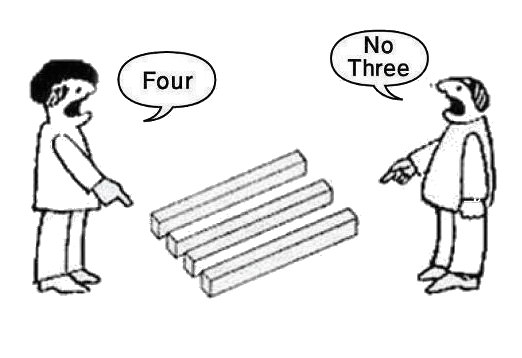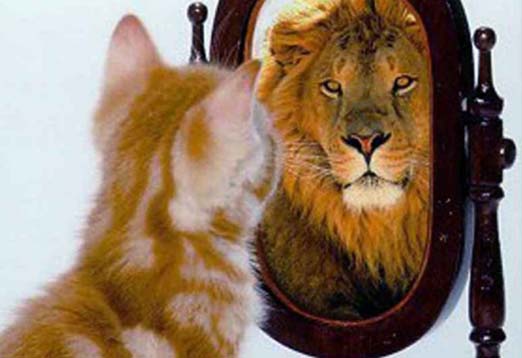A CEO PRIORITY, THE MANAGEMENT OF PERCEPTIONS
“In the eighteenth century, the philosopher Immanuel Kant argued that we can never have access to the “ding an sich”, the unfiltered “thing-in-itself” of objective reality. Great minds of history have taken up this perplexing question again and again. They all had theories, but now neuroscience has an answer. The answer is that we don’t see reality.
The world exists. It’s just that we don’t see it. We do not experience the world as it is because our brain didn’t evolve to do so. It’s a paradox of sorts: Your brain gives you the impression that your perceptions are objectively real, yet the sensory processes that make perception possible actually separate you from ever accessing that reality directly.”
 From the Book DEVIATE, The Science of seeing differently.
From the Book DEVIATE, The Science of seeing differently.
By Dr. Beau Lotto. *
The CEO is either a Leader or an Administrator.
The Leader has Vision and from this Vision stem the selected goals of the organization that he/she does not administer but lead.
The management of perceptions is a key priority for the successful Leader.
While Leadership evolves from cultivated talent and Vision is a complex internal intellectual process, employee management of perceptions is, a communication process by which they adopt the goals desired by their Leader through their implicit endorsement.
Employee perceptions can predict the performance of the organization as a whole. If employees have a favorable attitude toward their jobs, their companies tend to have greater worker retention, more loyalty among customers, and better financial performance. Employee perceptions affect results more than results affect perceptions of their job.
Perceptions of employees can be shaped by a clear but simplified communication of the goals of the Company.
This is in no way related to misrepresentation or advertising.
A deep understanding of other people’s perceptions on any issue is a prerequisite for any successful management of people towards a desired end.
We are not all in the same page. We are not even on the same chapter and often we are not even on the same book.
The CEO’s job is to form all the employee’s perceptions into a motivation to get them to move towards the desired direction.
There are two kinds of perception:
- Trade perceptions
- Personal perceptions
Trade perceptions can be summed up with the phrase “if you only have a hammer, every problem is a nail”.

For a junior Marketing manager, every problem is a case of analytics and/or advertisement.
For a junior Project Manager, every problem is one of time and cost.
This is as it should be on respective professional levels and departments, but it cannot be the guiding force leading a company.
Understanding that every suggestion coming from a department is strongly influenced by the perceptions of this department and making allowances for it, is the CEO’s job. The CEO must understand that every proposal is only part of the solution and judge to what extent the proposal is influenced from that department’s perceptions.
The Personal Perceptions are the most complex and difficult to manage but they are also the most fruitful. Each employee sees the organization in two ways. The public, open one and the subconscious, hidden one.

Because the employee’s work is a significant or even dominant part of his/her life, the organization that the employee works for, is a major part of his/her existential perceptions.
An employee is, consciously or subconsciously, for or against the organization he/she works for, but never neutral.
The perception by the employee that the Vision of the Leader coincides with his/her own interests is the greatest force that a Leader can develop inside the organization.
The difficulty lies in that people recognize always a crude effort to shape their perceptions and react subliminally against it, mostly silently, which is very dangerous.
Shaping of perceptions and honesty are not contradictory terms. The Leader must understand what is the accepted “coin” at every level of the organization.
Most people live within their perceived norm. Few people think in terms of action to reach another perceived norm.
Therefore, any Vision and Leadership goals must be “translated” to be understood by the different norms within the organization.
To give a concrete example, the rowers in a galley should not be expected to share the Vision and goals of the commanding Admiral.
They can however row better if they perceive that under the leadership of this commanding Admiral their conditions are improved, mostly in the sense of rationalization.
The rowers of the Athenian triremes were volunteers and poor Athenian citizens. Themistocles enticed them with two proposals:
That if they would build a fleet, they, as rowers will be paid a drachma per day, which was not guaranteed in civilian life, and also that they will be important in the defense of Athens as their much superior class of Hoplites, who traditionally fought in the wars and had all the glory.
By combining the material with the moral Themistocles gave them both salary and dignity and got them to vote for a fleet in which they would have the lowest but most vital job.
Themistocles worked on their perceptions of class and honor within their accepted norm, as hard manual work was their accepted norm, but did not cheat them. He made them feel part of the overall effort of their City State and genuine sharers of the glory of Victory, while giving them a better subsistence.
By working within the accepted perceptions of this class he created the naval might of the Athenian Maritime Empire.
One thing is certain. One cannot motivate employees by just buying them off. Motivation is created through perception management. The concept of motivation of top employees in not the same with that of the staff and particularly line employees.
The art of the CEO is to inspire the employees to share his much-modified vision for the goals of the organization. This modification is a form of translation, necessary to make the vision accepted by the employees, not because it is a must, but an ideal they understand and embrace, as it gives them the feeling that by working for the goals of the organization, they are fulfilling their own self-perception.
The unprecedented power of the communication tools that the modern CEO has at his/her disposal are awesome but must be used wisely. Every tweet from the CEO that is addressed to customers, peers or anybody else will also be read by the employees.
Employees are likely to remember these tweets long after anybody else has forgotten them.
It is so with any other social media and form of communication. The CEO must remember that every public word or gesture shapes the employee’s perception of their boss.
The external perception of the organizations is strongly influenced by the personality of their CEOs. While the CEO cannot be all things to all people, most of his/her actions must be in line with the image and the message desired to project about the CEO’s organization. All successful CEOs have a team taking care of their public persona.
The CEO’s public persona is not to be confused with his private one. Without being deceptive, it must carry only some traits of his/her private persona, some emphasized and others attenuated.
That brings this article to its end by describing what John Keegan, the Historian, very aptly, named as “The mask of Command”.
The public and the private persona of the CEO do not coincide. But as Keegan points out, the cultural impact on leadership is best exploited by understanding what is the posture and style of the Leader that is best accepted by a Society at certain times and places.
In his introduction, he emphasizes that he is not seeking a universal or general idea of leadership but rather a number of examples of how leadership and actions are a function of culture and society as much as of individual will.
In this way, Great Leaders have a public persona that coincides with the dominant perceptions of their followers, be they acolytes, soldiers, or in this case, employees, which is in harmony with the culture and society of the times. That is what he calls “The mask of command”.
Our times expect a leader to be simple in appearance, short and succinct in his messages, intelligent rather than witty, have a sense of humor, have clear opinions rather than be bland, and capable of delivering value content in a social environment.
The Leader must always remember that the distance between admiration and resentment is very short.
A Leader must be perceived to be successful in his leadership of the Company vs. successful for himself.
The often-misused expression that perception is reality should be changed into:
Perception shapes reality

*Dr. Beau Lotto is a globally renowned neuroscientist whose studies in human perception have taken him well beyond the scientific domain and into the fields of education, the arts and business.

